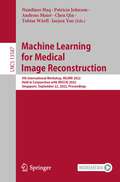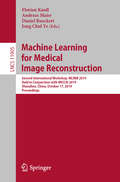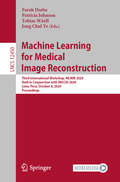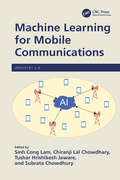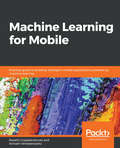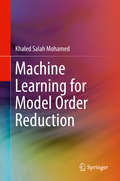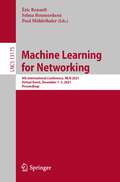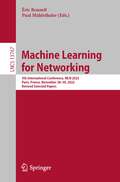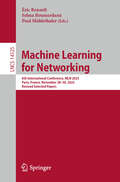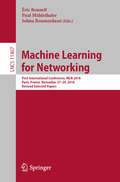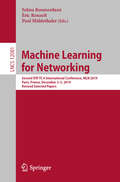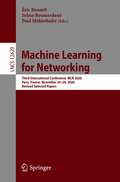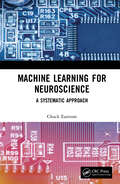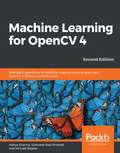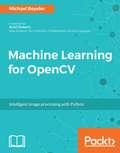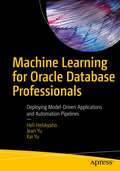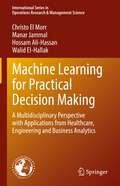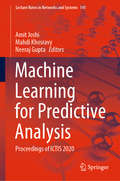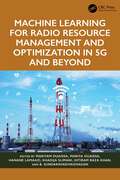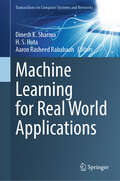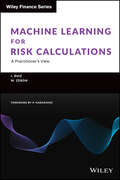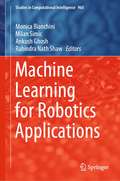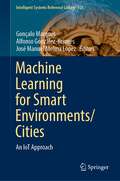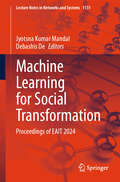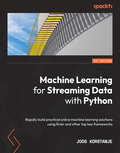- Table View
- List View
Machine Learning for Medical Image Reconstruction: 5th International Workshop, MLMIR 2022, Held in Conjunction with MICCAI 2022, Singapore, September 22, 2022, Proceedings (Lecture Notes in Computer Science #13587)
by Patricia Johnson Andreas Maier Tobias Würfl Nandinee Haq Jaejun Yoo Chen QinThis book constitutes the refereed proceedings of the 5th International Workshop on Machine Learning for Medical Reconstruction, MLMIR 2022, held in conjunction with MICCAI 2022, in September 2022, held in Singapore.The 15 papers presented were carefully reviewed and selected from 19 submissions. The papers are organized in the following topical sections: deep learning for magnetic resonance imaging and deep learning for general image reconstruction.
Machine Learning for Medical Image Reconstruction: Second International Workshop, MLMIR 2019, Held in Conjunction with MICCAI 2019, Shenzhen, China, October 17, 2019, Proceedings (Lecture Notes in Computer Science #11905)
by Daniel Rueckert Andreas Maier Florian Knoll Jong Chul YeThis book constitutes the refereed proceedings of the Second International Workshop on Machine Learning for Medical Reconstruction, MLMIR 2019, held in conjunction with MICCAI 2019, in Shenzhen, China, in October 2019. The 24 full papers presented were carefully reviewed and selected from 32 submissions. The papers are organized in the following topical sections: deep learning for magnetic resonance imaging; deep learning for computed tomography; and deep learning for general image reconstruction.
Machine Learning for Medical Image Reconstruction: Third International Workshop, MLMIR 2020, Held in Conjunction with MICCAI 2020, Lima, Peru, October 8, 2020, Proceedings (Lecture Notes in Computer Science #12450)
by Patricia Johnson Jong Chul Ye Farah Deeba Tobias WürflThis book constitutes the refereed proceedings of the Third International Workshop on Machine Learning for Medical Reconstruction, MLMIR 2020, held in conjunction with MICCAI 2020, in Lima, Peru, in October 2020. The workshop was held virtually. The 15 papers presented were carefully reviewed and selected from 18 submissions. The papers are organized in the following topical sections: deep learning for magnetic resonance imaging and deep learning for general image reconstruction.
Machine Learning for Mobile Communications (Industry 5.0)
by Chiranji Lal Chowdhary Subrata Chowdhury Sinh Cong Lam Tushar Hrishikesh JawareMachine Learning for Mobile Communications will take readers on a journey from basic to advanced knowledge about mobile communications and machine learning. For learners at the basic level, this book volume discusses a wide range of mobile communications topics from the system level, such as system design and optimization, to the user level, such as power control and resource allocation. The authors also review state-of-the-art machine learning, one of the biggest emerging trends in both academia and industry. For learners at the advanced level, this book discusses solutions for long-term problems with future mobile communications such as resource allocation, security, power control, and spectral efficiency. The book brings together some of the top mobile communications and machine learning experts throughout the world, who contributed their knowledge and experience regarding system design and optimization.This book: Discusses the 5G new radio system design and architecture as specified in 3GPP documents Highlights the challenges including security and privacy, energy, and spectrum efficiency from the perspective of 5G new radio systems Identifies both theoretical and practical problems that can occur in mobile communication systems Covers machine learning techniques such as autoencoder and Q-learning in a comprehensive manner Explores how to apply machine learning techniques to mobile systems to solve modern problems This book is for senior undergraduate and graduate students and academic researchers in the fields of electrical engineering, electronics and communication engineering, and computer engineering.
Machine Learning for Mobile: Practical guide to building intelligent mobile applications powered by machine learning
by Revathi Gopalakrishnan Avinash VenkateswarluLeverage the power of machine learning on mobiles and build intelligent mobile applications with ease Key Features Build smart mobile applications for Android and iOS devices Use popular machine learning toolkits such as Core ML and TensorFlow Lite Explore cloud services for machine learning that can be used in mobile apps Book Description Machine learning presents an entirely unique opportunity in software development. It allows smartphones to produce an enormous amount of useful data that can be mined, analyzed, and used to make predictions. This book will help you master machine learning for mobile devices with easy-to-follow, practical examples. You will begin with an introduction to machine learning on mobiles and grasp the fundamentals so you become well-acquainted with the subject. You will master supervised and unsupervised learning algorithms, and then learn how to build a machine learning model using mobile-based libraries such as Core ML, TensorFlow Lite, ML Kit, and Fritz on Android and iOS platforms. In doing so, you will also tackle some common and not-so-common machine learning problems with regard to Computer Vision and other real-world domains. By the end of this book, you will have explored machine learning in depth and implemented on-device machine learning with ease, thereby gaining a thorough understanding of how to run, create, and build real-time machine-learning applications on your mobile devices. What you will learn Build intelligent machine learning models that run on Android and iOS Use machine learning toolkits such as Core ML, TensorFlow Lite, and more Learn how to use Google Mobile Vision in your mobile apps Build a spam message detection system using Linear SVM Using Core ML to implement a regression model for iOS devices Build image classification systems using TensorFlow Lite and Core ML Who this book is for If you are a mobile app developer or a machine learning enthusiast keen to use machine learning to build smart mobile applications, this book is for you. Some experience with mobile application development is all you need to get started with this book. Prior experience with machine learning will be an added bonus
Machine Learning for Model Order Reduction
by Khaled Salah MohamedThis Book discusses machine learning for model order reduction, which can be used in modern VLSI design to predict the behavior of an electronic circuit, via mathematical models that predict behavior. The author describes techniques to reduce significantly the time required for simulations involving large-scale ordinary differential equations, which sometimes take several days or even weeks. This method is called model order reduction (MOR), which reduces the complexity of the original large system and generates a reduced-order model (ROM) to represent the original one. Readers will gain in-depth knowledge of machine learning and model order reduction concepts, the tradeoffs involved with using various algorithms, and how to apply the techniques presented to circuit simulations and numerical analysis.Introduces machine learning algorithms at the architecture level and the algorithm levels of abstraction;Describes new, hybrid solutions for model order reduction;Presents machine learning algorithms in depth, but simply;Uses real, industrial applications to verify algorithms.
Machine Learning for Networking: 4th International Conference, MLN 2021, Virtual Event, December 1–3, 2021, Proceedings (Lecture Notes in Computer Science #13175)
by Selma Boumerdassi Éric Renault Paul MühlethalerThis book constitutes the thoroughly refereed proceedings of the 4th International Conference on Machine Learning for Networking, MLN 2021, held in Paris, France, in December 2021. The 10 revised full papers included in the volume were carefully reviewed and selected from 30 submissions. They present and discuss new trends in in deep and reinforcement learning, pattern recognition and classification for networks, machine learning for network slicing optimization, 5G systems, user behavior prediction, multimedia, IoT, security and protection, optimization and new innovative machine learning methods, performance analysis of machine learning algorithms, experimental evaluations of machine learning, data mining in heterogeneous networks, distributed and decentralized machine learning algorithms, intelligent cloud-support communications, resource allocation, energy-aware communications, software-defined networks, cooperative networks, positioning and navigation systems, wireless communications, wireless sensor networks, and underwater sensor networks.
Machine Learning for Networking: 5th International Conference, MLN 2022, Paris, France, November 28–30, 2022, Revised Selected Papers (Lecture Notes in Computer Science #13767)
by Éric Renault Paul MühlethalerThis book constitutes the post-conference proceedings of the 5th International Conference on Machine Learning for Networking, MLN 2022, held in Paris, France, November 28–30, 2022. The 12 full papers presented in this book were carefully reviewed and selected from 27 submissions. The papers present novel ideas, results, experiences and work-in-process on all aspects of Machine Learning and Networking.
Machine Learning for Networking: 6th International Conference, MLN 2023, Paris, France, November 28–30, 2023, Revised Selected Papers (Lecture Notes in Computer Science #14525)
by Selma Boumerdassi Éric Renault Paul MühlethalerThis book constitutes the refereed proceedings of the 6th International Conference on Machine Learning for Networking, MLN 2023, held in Paris, France, during November 28–30, 2023. The 18 full papers included in this book were carefully reviewed and selected from 34 submissions. The conference aims at providing a top forum for researchers and practitioners to present and discuss new trends in machine learning, deep learning, pattern recognition and optimization for network architectures and services.
Machine Learning for Networking: First International Conference, MLN 2018, Paris, France, November 27–29, 2018, Revised Selected Papers (Lecture Notes in Computer Science #11407)
by Selma Boumerdassi Éric Renault Paul MühlethalerThis book constitutes the thoroughly refereed proceedings of the First International Conference on Machine Learning for Networking, MLN 2018, held in Paris, France, in November 2018. The 22 revised full papers included in the volume were carefully reviewed and selected from 48 submissions. They present new trends in the following topics: Deep and reinforcement learning; Pattern recognition and classification for networks; Machine learning for network slicing optimization, 5G system, user behavior prediction, multimedia, IoT, security and protection; Optimization and new innovative machine learning methods; Performance analysis of machine learning algorithms; Experimental evaluations of machine learning; Data mining in heterogeneous networks; Distributed and decentralized machine learning algorithms; Intelligent cloud-support communications, resource allocation, energy-aware/green communications, software defined networks, cooperative networks, positioning and navigation systems, wireless communications, wireless sensor networks, underwater sensor networks.
Machine Learning for Networking: Second IFIP TC 6 International Conference, MLN 2019, Paris, France, December 3–5, 2019, Revised Selected Papers (Lecture Notes in Computer Science #12081)
by Selma Boumerdassi Éric Renault Paul MühlethalerThis book constitutes the thoroughly refereed proceedings of the Second International Conference on Machine Learning for Networking, MLN 2019, held in Paris, France, in December 2019. The 26 revised full papers included in the volume were carefully reviewed and selected from 75 submissions. They present and discuss new trends in deep and reinforcement learning, patternrecognition and classi cation for networks, machine learning for network slicingoptimization, 5G system, user behavior prediction, multimedia, IoT, securityand protection, optimization and new innovative machine learning methods, performanceanalysis of machine learning algorithms, experimental evaluations ofmachine learning, data mining in heterogeneous networks, distributed and decentralizedmachine learning algorithms, intelligent cloud-support communications,ressource allocation, energy-aware communications, software de ned networks,cooperative networks, positioning and navigation systems, wireless communications,wireless sensor networks, underwater sensor networks.
Machine Learning for Networking: Third International Conference, MLN 2020, Paris, France, November 24–26, 2020, Revised Selected Papers (Lecture Notes in Computer Science #12629)
by Selma Boumerdassi Éric Renault Paul MühlethalerThis book constitutes the thoroughly refereed proceedings of the Second International Conference on Machine Learning for Networking, MLN 2019, held in Paris, France, in December 2019. The 26 revised full papers included in the volume were carefully reviewed and selected from 75 submissions. They present and discuss new trends in deep and reinforcement learning, pattern recognition and classification for networks, machine learning for network slicing optimization, 5G system, user behavior prediction, multimedia, IoT, security and protection, optimization and new innovative machine learning methods, performance analysis of machine learning algorithms, experimental evaluations of machine learning, data mining in heterogeneous networks, distributed and decentralized machine learning algorithms, intelligent cloud-support communications, ressource allocation, energy-aware communications, software de ned networks, cooperative networks, positioning and navigation systems, wireless communications, wireless sensor networks, underwater sensor networks.
Machine Learning for Neuroscience: A Systematic Approach
by Chuck EasttomThis book addresses the growing need for machine learning and data mining in neuroscience. The book offers a basic overview of the neuroscience, machine learning and the required math and programming necessary to develop reliable working models. The material is presented in a easy to follow user-friendly manner and is replete with fully working machine learning code. Machine Learning for Neuroscience: A Systematic Approach, tackles the needs of neuroscience researchers and practitioners that have very little training relevant to machine learning. The first section of the book provides an overview of necessary topics in order to delve into machine learning, including basic linear algebra and Python programming. The second section provides an overview of neuroscience and is directed to the computer science oriented readers. The section covers neuroanatomy and physiology, cellular neuroscience, neurological disorders and computational neuroscience. The third section of the book then delves into how to apply machine learning and data mining to neuroscience and provides coverage of artificial neural networks (ANN), clustering, and anomaly detection. The book contains fully working code examples with downloadable working code. It also contains lab assignments and quizzes, making it appropriate for use as a textbook. The primary audience is neuroscience researchers who need to delve into machine learning, programmers assigned neuroscience related machine learning projects and students studying methods in computational neuroscience.
Machine Learning for OpenCV 4: Intelligent algorithms for building image processing apps using OpenCV 4, Python, and scikit-learn, 2nd Edition
by Michael Beyeler Aditya Sharma Vishwesh Ravi ShrimaliA practical guide to understanding the core machine learning and deep learning algorithms, and implementing them to create intelligent image processing systems using OpenCV 4 Key Features Gain insights into machine learning algorithms, and implement them using OpenCV 4 and scikit-learn Get up to speed with Intel OpenVINO and its integration with OpenCV 4 Implement high-performance machine learning models with helpful tips and best practices Book Description OpenCV is an opensource library for building computer vision apps. The latest release, OpenCV 4, offers a plethora of features and platform improvements that are covered comprehensively in this up-to-date second edition. You'll start by understanding the new features and setting up OpenCV 4 to build your computer vision applications. You will explore the fundamentals of machine learning and even learn to design different algorithms that can be used for image processing. Gradually, the book will take you through supervised and unsupervised machine learning. You will gain hands-on experience using scikit-learn in Python for a variety of machine learning applications. Later chapters will focus on different machine learning algorithms, such as a decision tree, support vector machines (SVM), and Bayesian learning, and how they can be used for object detection computer vision operations. You will then delve into deep learning and ensemble learning, and discover their real-world applications, such as handwritten digit classification and gesture recognition. Finally, you'll get to grips with the latest Intel OpenVINO for building an image processing system. By the end of this book, you will have developed the skills you need to use machine learning for building intelligent computer vision applications with OpenCV 4. What you will learn Understand the core machine learning concepts for image processing Explore the theory behind machine learning and deep learning algorithm design Discover effective techniques to train your deep learning models Evaluate machine learning models to improve the performance of your models Integrate algorithms such as support vector machines and Bayes classifier in your computer vision applications Use OpenVINO with OpenCV 4 to speed up model inference Who this book is for This book is for Computer Vision professionals, machine learning developers, or anyone who wants to learn machine learning algorithms and implement them using OpenCV 4. If you want to build real-world Computer Vision and image processing applications powered by machine learning, then this book is for you. Working knowledge of Python programming is required to get the most out of this book.
Machine Learning for OpenCV: Intelligent Algorithms For Building Image Processing Apps Using Opencv 4, Python, And Scikit-learn, 2nd Edition
by Michael BeyelerExpand your OpenCV knowledge and master key concepts of machine learning using this practical, hands-on guide. About This Book • Load, store, edit, and visualize data using OpenCV and Python • Grasp the fundamental concepts of classification, regression, and clustering • Understand, perform, and experiment with machine learning techniques using this easy-to-follow guide • Evaluate, compare, and choose the right algorithm for any task Who This Book Is For This book targets Python programmers who are already familiar with OpenCV; this book will give you the tools and understanding required to build your own machine learning systems, tailored to practical real-world tasks. What You Will Learn • Explore and make effective use of OpenCV's machine learning module • Learn deep learning for computer vision with Python • Master linear regression and regularization techniques • Classify objects such as flower species, handwritten digits, and pedestrians • Explore the effective use of support vector machines, boosted decision trees, and random forests • Get acquainted with neural networks and Deep Learning to address real-world problems • Discover hidden structures in your data using k-means clustering • Get to grips with data pre-processing and feature engineering In Detail Machine learning is no longer just a buzzword, it is all around us: from protecting your email, to automatically tagging friends in pictures, to predicting what movies you like. Computer vision is one of today's most exciting application fields of machine learning, with Deep Learning driving innovative systems such as self-driving cars and Google's DeepMind. OpenCV lies at the intersection of these topics, providing a comprehensive open-source library for classic as well as state-of-the-art computer vision and machine learning algorithms. In combination with Python Anaconda, you will have access to all the open-source computing libraries you could possibly ask for. Machine learning for OpenCV begins by introducing you to the essential concepts of statistical learning, such as classification and regression. Once all the basics are covered, you will start exploring various algorithms such as decision trees, support vector machines, and Bayesian networks, and learn how to combine them with other OpenCV functionality. As the book progresses, so will your machine learning skills, until you are ready to take on today's hottest topic in the field: Deep Learning. By the end of this book, you will be ready to take on your own machine learning problems, either by building on the existing source code or developing your own algorithm from scratch! Style and approach OpenCV machine learning connects the fundamental theoretical principles behind machine learning to their practical applications in a way that focuses on asking and answering the right questions. This book walks you through the key elements of OpenCV and its powerful machine learning classes, while demonstrating how to get to grips with a range of models.
Machine Learning for Oracle Database Professionals: Deploying Model-Driven Applications and Automation Pipelines
by Kai Yu Heli Helskyaho Jean YuDatabase developers and administrators will use this book to learn how to deploy machine learning models in Oracle Database and in Oracle’s Autonomous Database cloud offering. The book covers the technologies that make up the Oracle Machine Learning (OML) platform, including OML4SQL, OML Notebooks, OML4R, and OML4Py. The book focuses on Oracle Machine Learning as part of the Oracle Autonomous Database collaborative environment. Also covered are advanced topics such as delivery and automation pipelines.Throughout the book you will find practical details and hand-on examples showing you how to implement machine learning and automate deployment of machine learning. Discussion around the examples helps you gain a conceptual understanding of machine learning. Important concepts discussed include the methods involved, the algorithms to choose from, and mechanisms for process and deployment. Seasoned database professionals looking to make the leap into machine learning as a growth path will find much to like in this book as it helps you step up and use your current knowledge of Oracle Database to transition into providing machine learning solutions.What You Will LearnUse the Oracle Machine Learning (OML) Notebooks for data visualization and machine learning model building and evaluationUnderstand Oracle offerings for machine learningDevelop machine learning with Oracle database using the built-in machine learning packagesDevelop and deploy machine learning models using OML4SQL and OML4RLeverage the Oracle Autonomous Database and its collaborative environment for Oracle Machine LearningDevelop and deploy machine learning projects in Oracle Autonomous DatabaseBuild an automated pipeline that can detect and handle changes in data/model performance Who This Book Is ForDatabase developers and administrators who want to learn about machine learning, developers who want to build models and applications using Oracle Database’s built-in machine learning feature set, and administrators tasked with supporting applications on Oracle Database that make use of the Oracle Machine Learning feature set
Machine Learning for Practical Decision Making: A Multidisciplinary Perspective with Applications from Healthcare, Engineering and Business Analytics (International Series in Operations Research & Management Science #334)
by Hossam Ali-Hassan Christo El Morr Manar Jammal Walid EI-HallakThis book provides a hands-on introduction to Machine Learning (ML) from a multidisciplinary perspective that does not require a background in data science or computer science. It explains ML using simple language and a straightforward approach guided by real-world examples in areas such as health informatics, information technology, and business analytics. The book will help readers understand the various key algorithms, major software tools, and their applications. Moreover, through examples from the healthcare and business analytics fields, it demonstrates how and when ML can help them make better decisions in their disciplines. The book is chiefly intended for undergraduate and graduate students who are taking an introductory course in machine learning. It will also benefit data analysts and anyone interested in learning ML approaches.
Machine Learning for Predictive Analysis: Proceedings of ICTIS 2020 (Lecture Notes in Networks and Systems #141)
by Neeraj Gupta Amit Joshi Mahdi KhosravyThis book gathers papers addressing state-of-the-art research in the areas of machine learning and predictive analysis, presented virtually at the Fourth International Conference on Information and Communication Technology for Intelligent Systems (ICTIS 2020), India. It covers topics such as intelligent agent and multi-agent systems in various domains, machine learning, intelligent information retrieval and business intelligence, intelligent information system development using design science principles, intelligent web mining and knowledge discovery systems.
Machine Learning for Radio Resource Management and Optimization in 5G and Beyond
by Mariya Ouaissa Mariyam Ouaissa B. Sundaravadivazhagan Khadija Slimani Hanane Lamaazi Ihtiram Raza KhanMachine Learning for Radio Resource Management and Optimization in 5G and Beyond highlights a new line of research that uses innovative technologies and methods based on artificial intelligence/machine learning techniques to address issues and challenges related to radio resource management in 5G and 6G communication systems. This book provides comprehensive coverage of current and emerging waveform design, channel modeling, multiple access, random access, scheduling, network slicing, and resource optimization for 5G wireless networks and beyond.This book is suitable for researchers, scholars, and industry professionals working in different fields related to mobile networks and intelligent systems. Additionally, it serves as a hands‑on resource for students interested in the fields of cellular networks (5G/6G) and computational intelligence.
Machine Learning for Real World Applications (Transactions on Computer Systems and Networks)
by Dinesh K. Sharma H. S. Hota Aaron Rasheed RababaahThis book provides a comprehensive coverage of machine learning techniques ranging from fundamental to advanced. The content addresses topics within the scope of the book from the ground up, providing readers with a trustworthy source of theoretical and technical learning content. The book emphasizes not only the theoretical features but also their practical and implementation aspects in real-world applications. These applications are crucial because they provide comprehensive experimental work that supports the validity of the offered approaches as well as clear instructions on how to apply such models in comparable and distinct settings and contexts. Furthermore, the chapters shed light on the problems and possibilities that researchers might use to direct their future research efforts. The book is beneficial for undergraduate and postgraduate students, researchers, and industry personnel.
Machine Learning for Risk Calculations: A Practitioner's View (The Wiley Finance Series)
by Ignacio Ruiz Mariano ZeronState-of-the-art algorithmic deep learning and tensoring techniques for financial institutions The computational demand of risk calculations in financial institutions has ballooned and shows no sign of stopping. It is no longer viable to simply add more computing power to deal with this increased demand. The solution? Algorithmic solutions based on deep learning and Chebyshev tensors represent a practical way to reduce costs while simultaneously increasing risk calculation capabilities. Machine Learning for Risk Calculations: A Practitioner’s View provides an in-depth review of a number of algorithmic solutions and demonstrates how they can be used to overcome the massive computational burden of risk calculations in financial institutions. This book will get you started by reviewing fundamental techniques, including deep learning and Chebyshev tensors. You’ll then discover algorithmic tools that, in combination with the fundamentals, deliver actual solutions to the real problems financial institutions encounter on a regular basis. Numerical tests and examples demonstrate how these solutions can be applied to practical problems, including XVA and Counterparty Credit Risk, IMM capital, PFE, VaR, FRTB, Dynamic Initial Margin, pricing function calibration, volatility surface parametrisation, portfolio optimisation and others. Finally, you’ll uncover the benefits these techniques provide, the practicalities of implementing them, and the software which can be used. Review the fundamentals of deep learning and Chebyshev tensors Discover pioneering algorithmic techniques that can create new opportunities in complex risk calculation Learn how to apply the solutions to a wide range of real-life risk calculations. Download sample code used in the book, so you can follow along and experiment with your own calculations Realize improved risk management whilst overcoming the burden of limited computational power Quants, IT professionals, and financial risk managers will benefit from this practitioner-oriented approach to state-of-the-art risk calculation.
Machine Learning for Robotics Applications (Studies in Computational Intelligence #960)
by Milan Simic Monica Bianchini Ankush Ghosh Rabindra Nath ShawMachine learning has become one of the most prevalent topics in recent years. The application of machine learning we see today is a tip of the iceberg. The machine learning revolution has just started to roll out. It is becoming an integral part of all modern electronic devices. Applications in automation areas like automotive, security and surveillance, augmented reality, smart home, retail automation and healthcare are few of them. Robotics is also rising to dominate the automated world. The future applications of machine learning in the robotics area are still undiscovered to the common readers. We are, therefore, putting an effort to write this edited book on the future applications of machine learning on robotics where several applications have been included in separate chapters. The content of the book is technical. It has been tried to cover all possible application areas of Robotics using machine learning. This book will provide the future vision on the unexplored areas of applications of Robotics using machine learning. The ideas to be presented in this book are backed up by original research results. The chapter provided here in-depth look with all necessary theory and mathematical calculations. It will be perfect for laymen and developers as it will combine both advanced and introductory material to form an argument for what machine learning could achieve in the future. It will provide a vision on future areas of application and their approach in detail. Therefore, this book will be immensely beneficial for the academicians, researchers and industry project managers to develop their new project and thereby beneficial for mankind. Original research and review works with model and build Robotics applications using Machine learning are included as chapters in this book.
Machine Learning for Smart Environments/Cities: An IoT Approach (Intelligent Systems Reference Library #121)
by Alfonso González-Briones Gonçalo Marques José Manuel Molina LópezThis book introduces machine learning and its applications in smart environments/cities. At this stage, a comprehensive understanding of smart environment/city applications is critical for supporting future research. This book includes chapters written by researchers from different countries across the globe and identifies critical threads in research and also gaps that open up new and challenging lines of research for the future. Recent advances are discussed, and thorough reviews introduce readers to critical domains. The discussion on key research topics presented in this book accelerates smart city and smart environment implementations based on IoT technologies. Consequently, this book supports future research activities aimed at developing future IoT architectures for smart environments/cities.
Machine Learning for Social Transformation: Proceedings of EAIT 2024 (Lecture Notes in Networks and Systems #1131)
by Debashis De Jyotsna Kumar MandalThe book includes original unpublished contributions presented at the Eighth International Conference on Emerging Applications of Information Technology (EAIT 2024), organized by Computer Society of India, Kolkata Chapter during 12 – 13 January 2024. The Theme of the conference is “Machine Learning for Social Transformation”. The book covers the topics such as computational intelligence for social transformation, machine learning for healthcare informatics, and machine learning for agriculture and environmental sustainability.
Machine Learning for Streaming Data with Python: Rapidly build practical online machine learning solutions using River and other top key frameworks
by Joos KorstanjeApply machine learning to streaming data with the help of practical examples, and deal with challenges that surround streamingKey FeaturesWork on streaming use cases that are not taught in most data science coursesGain experience with state-of-the-art tools for streaming dataMitigate various challenges while handling streaming dataBook DescriptionStreaming data is the new top technology to watch out for in the field of data science and machine learning. As business needs become more demanding, many use cases require real-time analysis as well as real-time machine learning. This book will help you to get up to speed with data analytics for streaming data and focus strongly on adapting machine learning and other analytics to the case of streaming data.You will first learn about the architecture for streaming and real-time machine learning. Next, you will look at the state-of-the-art frameworks for streaming data like River. Later chapters will focus on various industrial use cases for streaming data like Online Anomaly Detection and others. As you progress, you will discover various challenges and learn how to mitigate them. In addition to this, you will learn best practices that will help you use streaming data to generate real-time insights.By the end of this book, you will have gained the confidence you need to stream data in your machine learning models.What you will learnUnderstand the challenges and advantages of working with streaming dataDevelop real-time insights from streaming dataUnderstand the implementation of streaming data with various use cases to boost your knowledgeDevelop a PCA alternative that can work on real-time dataExplore best practices for handling streaming data that you absolutely need to rememberDevelop an API for real-time machine learning inferenceWho this book is forThis book is for data scientists and machine learning engineers who have a background in machine learning, are practice and technology-oriented, and want to learn how to apply machine learning to streaming data through practical examples with modern technologies. Although an understanding of basic Python and machine learning concepts is a must, no prior knowledge of streaming is required.
